Groundbreaking to Game-Changing: Innovating Spaces for Women in Sports
Here in Kansas City, making history is kind of our thing and March 16th 2024 was no exception. Since its inception, KC Current has been a trailblazer in the world of women’s sports; putting their money where their mouth is by making substantial investments into projects that elevate the team to elite status. In 2022 they unveiled the first NWSL specific training facility and merely two years later opened the very first stadium purpose-built for women’s sports in the entire world, CPKC Stadium.
Behind the scenes of this incredible facility is Generator Studio, an architecture and interior design firm local to Kansas City. With a multitude of professional renovations under their belt, Generator knows a thing or two about bringing women’s sporting facilities to life.
“A lot of these spaces are gearing towards a hospitality approach rather than a sports forward perspective,” said Kaitlyn Mahnken, lead interior designer at Generator Studio. “Clients want a tailored high-end look, especially when it's a facility specifically for women. By incorporating soft curves, vibrant patterns and striking contrasts it brings forward a woman-centric charm.”
Sports as an industry is often considered a “man's world.” It’s a place for the bros and has, for many years, given the feeling that it's not always an incredibly diverse space. Sports design is no different, but the women within the field are coming to change that.
At Shield, working with kickass women is par for the course, so we wanted to sit down and pick the brains of these professionals who are opening doors and making waves with us as well as with others. We’re not just here to go, “woo women,” we’re here to showcase the achievements of these architects and interior designers who are bringing equality to the sporting world one facility at a time.
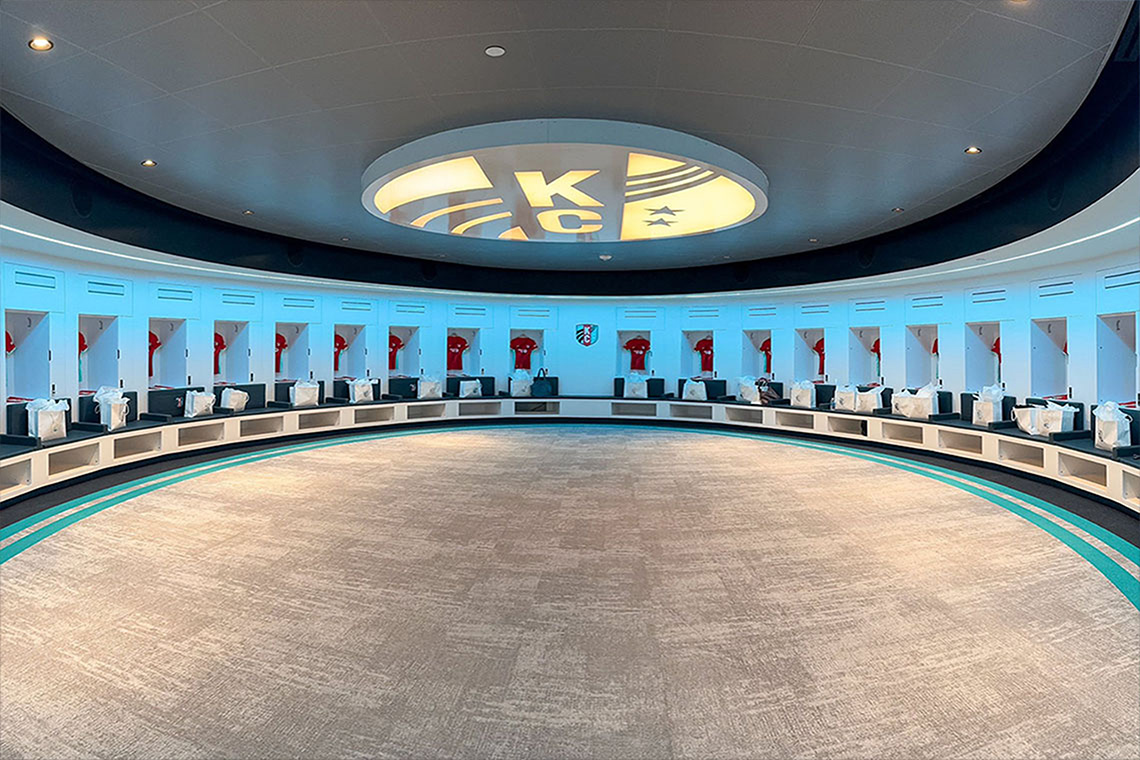
kc current locker room
cpkc stadium: the first, but not the last
Kaitlyn Mahnken was just leaving college as the Covid pandemic hit and found herself a bit in over her head as a new interior designer. After stumbling upon the opportunity to work at Generator Studio she took the chance and immediately began working on what would become CPKC Stadium.
“I was only a year and a half out of school when Covid hit,” said Mahnken. “The firm I worked at underwent a substantial reduction in workforce and I was lucky enough to be one of the few they kept. During this time, I didn't always get to work on the most exciting projects, so when the opportunity arose to work at Generator, I took it.”
CPKC Stadium is purpose-built for women’s sports, which means that there were aspects taken into consideration that sometimes aren’t when creating a men’s arena or a combined facility. From physicality to body build to belongings, women’s spaces must be created with these differences from men in mind. Any change that can be made to make a player’s day in the facility more efficient (even down to the lockers) was made a priority.
Their own locker room in their OWN stadium. 💅@michelle1cooper taking a victory lap 🤣 pic.twitter.com/uJxk6ZrLbo
— KC Current (@thekccurrent) March 13, 2024
“Height was a huge factor when we were looking at the lockers,” said Mahnken. “We had to do sit/stand tests and utilize diagrams due to the average NWSL player being only 5’7, whereas your average male soccer player may be 5’10-5’11. We needed to create a design where they could reach their storage gracefully, without having to step on the bench compartment.”
The lockers also included more space for street clothing and a smaller central section to account for the jersey size. Showing off your gear as a player is incredibly important and can be a great way to bring personalization into the space when the media takes photos.
“The ownership group really specified that they wanted to have their kit facing forward,” said Mahnken. “Female jerseys tend to be much smaller than male jerseys, which allowed us to allocate more space for their street clothes, while also figuring out how large the kit display space was going to be.”
CPKC Stadium is the beginning of an era. With a renewed focus on women’s specific sporting facilities, Generator hopes that other teams will see what Kansas City has done and run with the inspiration.
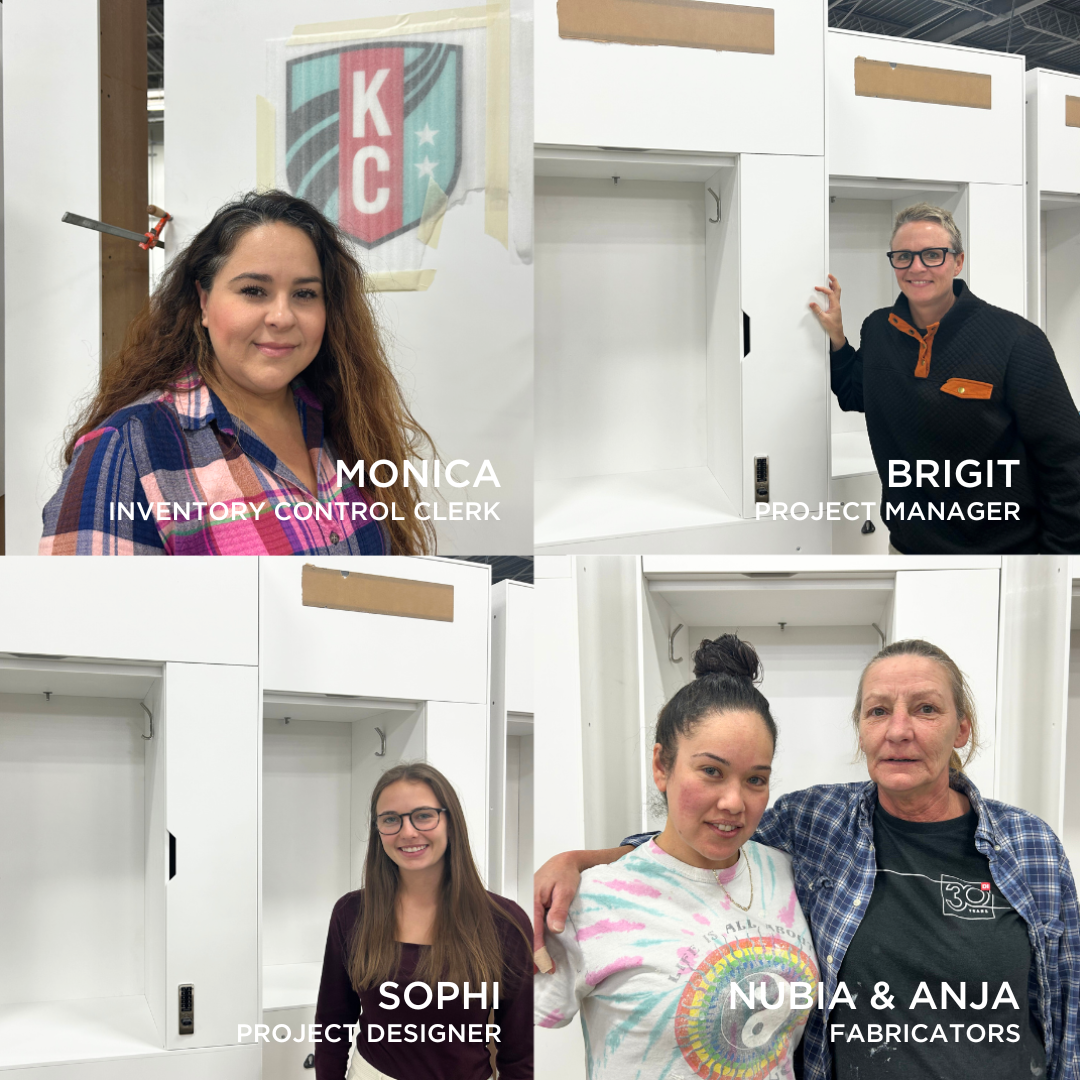
shield lockers employees who worked on the kc current lockers
“While we were working with the Kansas City Current ownership team they would always say, ‘we are the first but we’re not the last,’ and that’s really all we can hope for,” said Mahnken. “I hope that teams take what KC Current has done, elevate it and make it their own.”
Working alongside Generator to create the lockers for CPKC Stadium was an absolute dream, but professional teams shouldn’t be the only ones whose facilities get the focus. Collegiate athletics are moving in their own new direction.
investing in equality
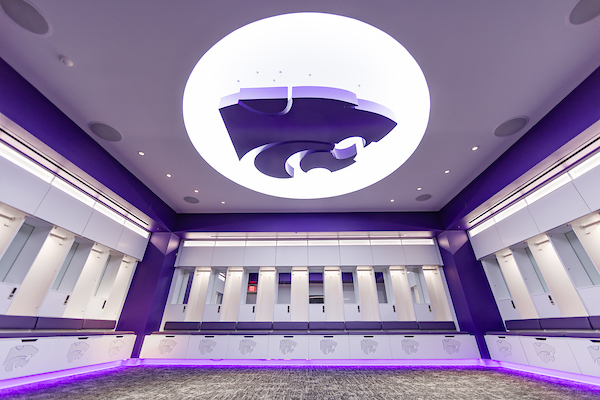
kansas state university volleyball locker room
Growing up Emily Ostertag spent most of her life in the water. Being a competitive swimmer at the University of Wisconsin, she got to see up close and personal just how much women’s facilities were lacking on the collegiate level.
“The facility that I trained in at the University of Wisconsin was windowless and depressing. Not having natural light was awful,” said Ostertag, senior project interior designer at HOK. “For the level of program that we were, it was really underwhelming.”
Now Ostertag works specifically on sporting facilities as an interior designer so other students don’t have to feel the same way she felt practicing in an underfunded space.
In fact, HOK won the project to tear down her old swim facility at the University of Wisconsin which she then got to serve as the head interior designer to build the new facility, The Nicholas Recreation Center or “The Nick.”
With Shield, Ostertag worked on renovating the Kansas State volleyball locker room to create a more open and modern feeling, as well as a more functional space for the players. She specifically wanted to see women’s lockers given the same flashy features that are often added to men’s.
kansas state university volleyball locker room reveal
“I think with locker rooms and lockers, we’re seeing more integration of technology,” said Ostertag. “We’ve been requested to do digital nameplates… Adding both functional lighting and accent or color changing lighting is also commonly requested.”
Seen within the Kansas State volleyball lockers is integrated feature lighting on the top as well as purple lighting on the bottom that matches the Wildcat’s signature colors. Specializations like these allow players to truly own the space, something that Ostertag sees slowly but surely becoming more widely seen in both women’s and men’s spaces.
“I think the focus isn’t on women’s sports because they don’t generate as much revenue,” said Ostertag. “A lot of the time locker room renovations or facility improvements are done based on Title Nine and the requirement to have equal facilities for both men and women.”
Given time, Ostertag hopes to see more focus put on women’s collegiate spaces less because of requirements and more so out of a want to invest in these programs.
securing legitimacy
From a young age, Kristin Byrd knew she loved design, but often felt constricted by the questions she was asked by others.
“I didn’t even realize that you could specialize in sports architecture when I went to school,” said Byrd, design director and architect at Gensler. “All anyone ever asked was, ‘do you want to do residential or commercial?’ but no one told us there is so much more than that.”
Byrd originally started working for HNTB, but once she saw a chance to move to Gensler and focus on sports, she went for it and never looked back.
“I have had really great and varied project opportunities in my career, but I knew on the inside that once sports was an option, that was where I needed to be” said Byrd.
To Byrd, the importance of opening facilities specifically for women lies in the fact that once these teams have greater resources, they become more legitimized to the public. It also allows for issues more specific to women to be addressed within the facilities.
“Building these new and upgraded women’s facilities is fundamental because it starts to raise the bar one team at a time,” said Byrd. “Teams and athletes will start to compare their facilities, which ultimately means many teams will need to level up and start securing more funding. We’re also starting to address women’s specific needs in the ‘sports workplace.’ One great amenity we are starting to see is the desire to have childcare integrated into the training facility itself. This helps to take some of the mental load off of the athlete so they can get back to focusing on their day job.”
With Shield, Byrd is currently working on a locker room renovation for the New Orleans Saints, of which everything is still private. Separately, with Gensler, she lead the design for the San Diego FC Right to Dream Academy.
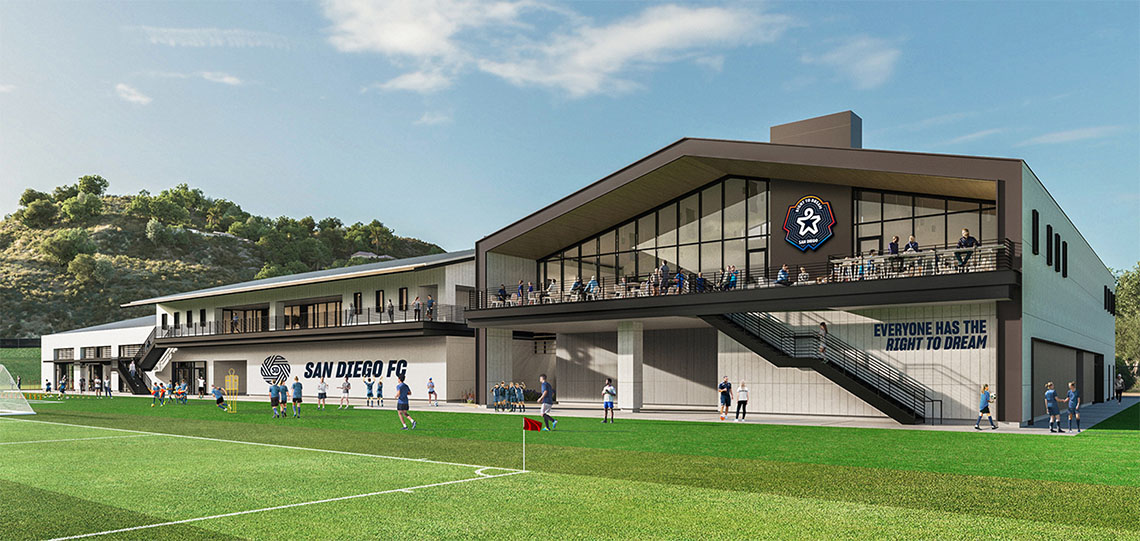
san diego fc right to dream academy
Just one example of teams gaining more funding and upping their standing is New York Liberty, a WNBA team based in Brooklyn. Completed in the summer of 2021, the renovation was yet another collaboration between Generator Studio and Shield Lockers. For the team, the upgrade was about making sure professional level players have professional level spaces.
As told by New York Liberty CEO Keia Clarke, the project was made by women, for women.
"A group of world-class athletes deserve a world-class space, and that is precisely what Shawmut and Generator Studios have created with this new locker room," said Clarke. "The Liberty continues to be intentional about uplifting women in all facets of the company and this renovation project is no different."
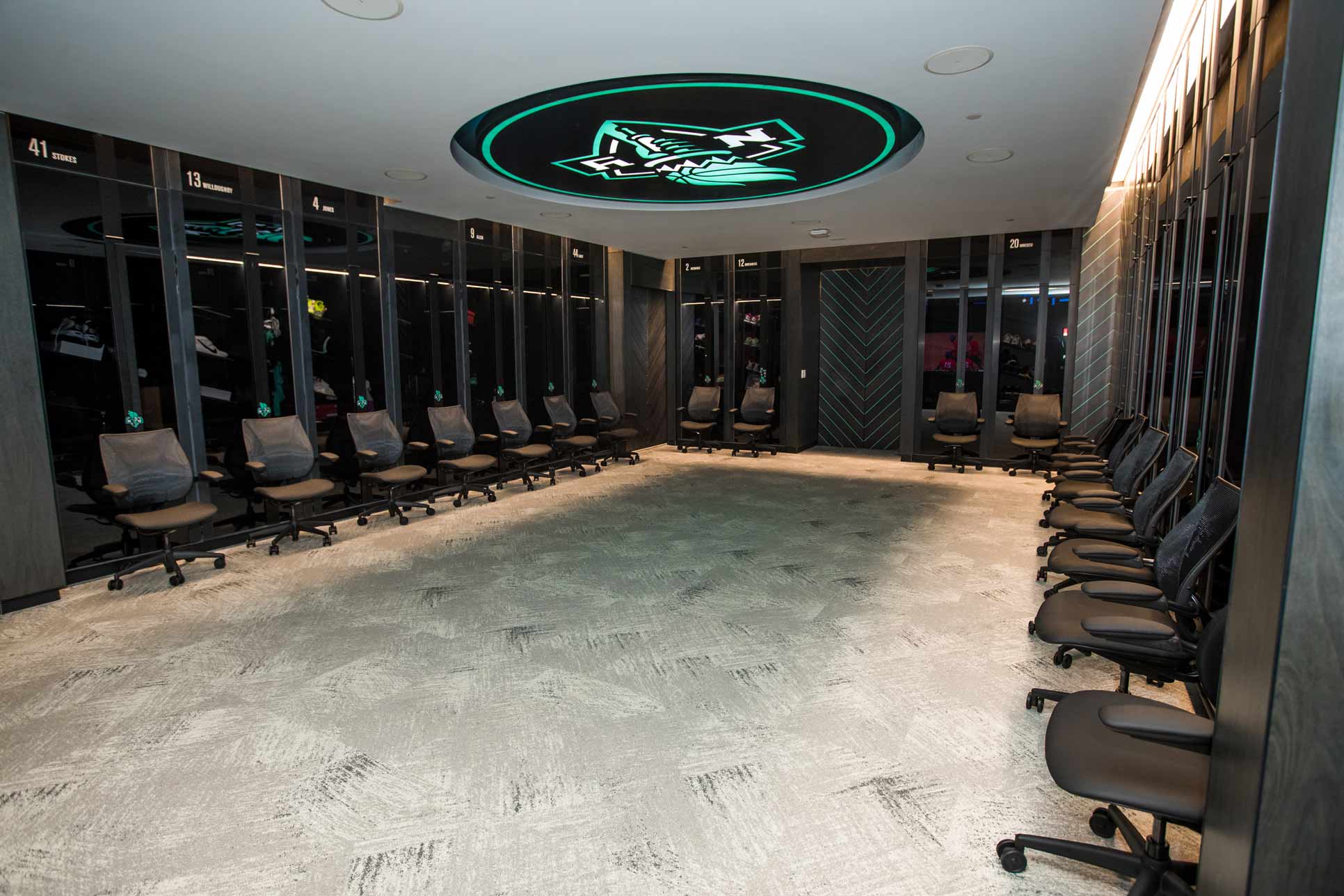
new york liberty locker room
more women everywhere
Another architect who found her passion from a young age, Megan Rand, has also been a champion of both mixed facilities where men and women play, as well as women focused sporting spaces.
To Rand, creating spaces not only for the athletes but also the fans is a top priority. With sporting events becoming more about the people you are going with and less about the actual outcome of the game, having varied spaces to enjoy these events can be a make or break for the teams.
With Shield, Rand worked on the expansion and renovation of the University of Utah football stadium and locker room. For her, the project signified bringing ideas together to create something incredible.
“I always say Ken Garff Red Zone at Utah's Rice-Eccles Stadium is pretty high up there for me because there were so many entities involved in that facility,” said Rand, Senior Associate at Populous. “There had been a vision for that stadium expansion for a while and then it turned out really successful because of the new trends we implemented from premium seating to new locker styles. Utah had two undefeated seasons at home after the opening in 2021, which was icing on the cake!”
university of utah football locker room reveal
Throughout her time in sports architecture, Rand has seen more women become a part of not only the design side, but also within the teams staff themselves. Because of this, it is now expected by many teams that there will be a strong female presence within the design team when working on the projects, in order to have an accurate point of view.
While many people think about women players, it can be easy to forget that women coaches and staff need their own space as well.
“We’ve seen an increase in female staff and it's very important to make sure those female staff get treated equally,” said Rand. “This includes female staff lockers, and looking at crossovers in shared spaces, such as a female staff member in a football recovery or sports medicine space.”
Whether you are working on a men’s space or a women’s space, there are a few aspects of equipment and design that will always reign supreme. For Rand, choosing products for spaces that will last and withstand damage is never going to go out of style. Mixing functionality with flair is a goal that almost every designer seeks to find the balance between, even for the small aspects of a space (which we like to focus on).
“Durability is a key point for locker design that's definitely high on equipment manager’s lists. Lockers should be easy to service or repair, withstand a lot of use and offer chances for lots of storage,” said Rand. “A lot of times we look for subtle ways to incorporate personalization into the locker that isn’t for anyone else but the player… I think it’s important to start collaboration in the beginning and build those relationships like the one we have with Shield. The Shield staff has always allowed us to bounce ideas off of them.”
Ultimately, what designers are looking for no matter who they are creating for is a chance to make something unique to the client. For teams that are upgrading their facilities, specifically women’s teams, it is important to remember that they will be living in these spaces for years to come, so they need to be made with design ideals that will stand the test of time but showcase their branding.
“What we don’t want to do is feel like we are picking out locker parts from a catalog,” said Rand. “It’s important that the manufacturers are willing to try different ideas and not push us into, ‘hey, these are your three design options.’”
Looking to the future
As we look towards the future, it's clear that women's teams are beginning to get their much deserved flowers. Building CPKC Stadium wasn't just a project - It was a statement, a declaration that women in sports deserve their own spaces to flourish and become their very best.
But it's not just the women on the field that are watching their industry expand. The professionals building these incredible facilities are also watching as sports design becomes a field that is more welcoming to women as a whole. For some, coming up in the industry was tough, and many of the women we spoke to hope that things don't have to stay the same for the women who are working to break in.
"At the start of my career, it took a little longer to gain respect and trust because I was one of the only women in the room," said Ostertag. "But now we see clients expecting more female presence on female projects."
For women with a passion for sports design, the professionals say go for it! Things change when more ideas get thrown into the mix, and more ideas can only be brought in if people decide to take the chance and reach into the industry.
"Be confident and trust your gut," said Rand. "A lot of times there's not many women in these spaces so knowing you are an integral member of the team is so important."
Locker room design is one of the major cornerstones in training, recruiting, performance, and recovery. It’s one of the major places where organizations can showcase their efforts to identify player and coaching needs. Make sure that whatever your next locker rooms ends up becoming, It starts by listening to current players and staff and bringing their ideas to the table.
